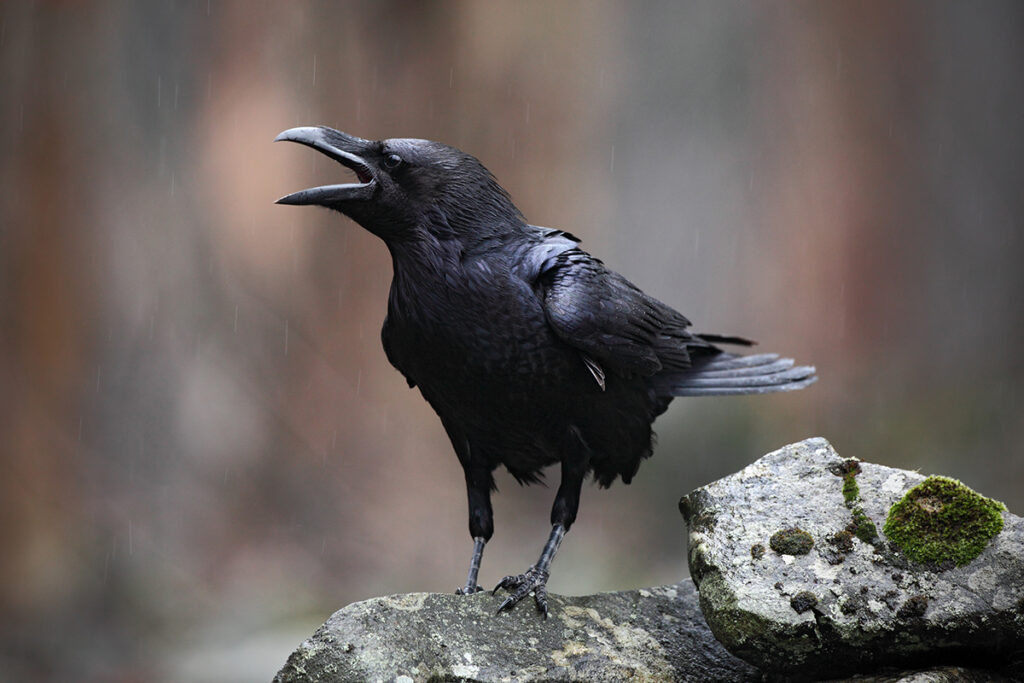There are only a handful of critters that share the wintery wonderland of our mountains with intrepid snowshoers, cross-country skiers, and downhill sliders. Earlier this season, friends saw a small heard of elk under the lift at 49 Degrees North, likely moving to lower elevations. Moose love to mess up the freshly groomed ski deck on the Mount Spokane Nordic trails. On a rare occasion, you can see a white ermine crossing a snow field or the wing prints from an owl’s nocturnal hunting. But probably the most gregarious high elevation dweller is the common raven, Corvus corax.
Ravens are one of the largest members of the Corvid family—highly intelligent birds that include jays, crows and magpies. They are also the most widely spread corvid, occupying almost every environment in the northern hemisphere from deserts and forests to high-elevation mountains. It is common to confuse crows and ravens. Along with being larger, ravens have a thicker bill with a distinct feather tuft over the base, and their tails are wedge- or diamond-shaped.
Ravens are excellent at surviving cold temperatures. They have high metabolisms, and to keep that furnace burning they have become incredibly good at finding food. They have excellent eyesight for finding those calories and can use their chisel-like bill to chip away at frozen food. They also have specialized feathers over their nostrils that help reduce water loss through breathing.
These birds can live up to 23 years in the wild and are social animals, congregating in groups when they are young. You can often see them engaging in play at these ages—playing keep away, locking talons and spinning, and sliding down a snowpack for fun (that last one sounds familiar). As they age, they are usually seen in their mate pairs.

These glossy black birds are incredibly intelligent. Recent studies have compared the intelligence of a 4-month-old raven to be equal to adult apes. They found that young ravens can grasp quantities, understand causation, and show social learning on par with the formerly studied apes. There are plenty of YouTube videos of ravens solving complex multi-part puzzles in order to find food. Ravens have even been found to demonstrate the capacity to communicate about objects that are distant in space or time. This has helped them be incredibly successful in acquiring their omnivorous diet.
Over my years of teaching skiing and snowboarding and trying to entertain kids on a 7-minute chairlift ride, I have perfected one guttural raven call, but ravens can have fifteen to 30 different kinds of vocalization that are used for social interaction. Like other corvids, they can also mimic sounds from their environment, including human sounds.
I experienced their smarts and tenacity firsthand on my first trip to Mt. Baker. These birds would watch where we would bury our food bags under rock or snow. No matter how hard we tried to fool them—digging false holes, flagging a few feet away from cached food—they would find the exact spot where our precious calories were stored.
This intelligence is probably what has led them to be featured in lore across the world, from Odin’s ravens, Hugin and Munin, to creation stories of many Native American tribes. For Pacific Northwest tribes, ravens are thought of as tricksters, keepers of secrets, gluttonous creatures, and there is a story of the raven bringing the sun and stars to the people.
It is the raven’s ability to adapt to so many environments and their gregarious nature that has connected with people across the globe. //
In between low-tide ski trips, Adam is working to advocate for our public lands. He is currently scheming some bikepacking adventures in the Colville National Forest.












